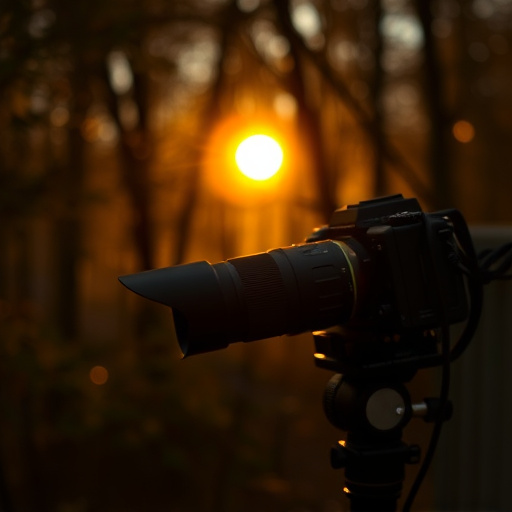In today's digital era, spy cameras hidden in everyday items pose a significant concern for childcare safety. The Spy Camera Childcare Safety Guide equips parents and caregivers with knowledge of electromagnetic signals used by these devices (RF, IR, Bluetooth), enabling them to use specialized detectors to identify hidden surveillance equipment. By understanding signal ranges, detection methods, and power outputs, parents can proactively mitigate threats and create safer environments for their children. Advanced signal scanning tools, strategically placed cameras in plain sight, and adherence to privacy protection and legal compliance are key aspects of implementing effective childcare safety surveillance systems.
In today’s digital age, ensuring childcare safety involves staying vigilant against hidden threats. This comprehensive guide explores surveillance device electromagnetic signal detection, an essential aspect of the Spy Camera Childcare Safety process. Understanding electromagnetic signals and their role in detection is key to identifying common surveillance device signals. Learn about advanced tools for scanning, best practices for discreet installation and testing, and crucial steps to ensure privacy and legal compliance while monitoring.
- Understanding Electromagnetic Signals and Their Role in Detection
- Identifying Common Surveillance Device Signals
- Utilizing Advanced Tools for Signal Scanning
- Best Practices for Discreet Installation and Testing
- Ensuring Privacy and Legal Compliance While Monitoring
Understanding Electromagnetic Signals and Their Role in Detection
Electromagnetic signals play a pivotal role in surveillance device detection, especially in scenarios like childcare safety where a Spy Camera Guide is essential. These signals are invisible to the naked eye but can be powerful indicators of potential hidden cameras or tracking devices. Understanding electromagnetic waves and their behavior is crucial for anyone looking to protect privacy and ensure child safety in homes or care facilities.
Different electronic devices emit unique electromagnetic signatures, from Wi-Fi routers to baby monitors. By analyzing these signals, specialized detectors can identify unusual patterns that might suggest the presence of hidden cameras. In childcare settings, this knowledge becomes a critical tool for parents and caregivers who want to create a safe environment. Regular checks for electromagnetic interference or unexpected signal activities could help uncover potential spy cameras, ensuring peace of mind and a secure space for children.
Identifying Common Surveillance Device Signals
In today’s digital age, spy cameras have evolved into sophisticated surveillance devices hidden in everyday objects like toys, clocks, or even picture frames. These covert cameras often transmit data through electromagnetic signals, making their detection a complex task. For parents seeking to ensure childcare safety with a Spy Camera Childcare Safety Guide, understanding these signals is crucial. Common signals include radio frequency (RF) transmissions, infrared (IR) pulses, and Bluetooth connectivity. RF signals are widely used due to their range and compatibility with various devices, making them harder to detect without specialized equipment. IR signals, on the other hand, require line-of-sight but offer excellent night vision capabilities. Bluetooth signals can be useful for identifying nearby devices but may be less conspicuous due to their lower power output.
By familiarizing themselves with these signal types and their characteristics, parents can actively monitor potential surveillance threats. This proactive approach is a vital part of the Spy Camera Childcare Safety Guide, empowering parents to take necessary precautions and create safer environments for their children.
Utilizing Advanced Tools for Signal Scanning
In the realm of spy camera childcare safety, advanced tools for signal scanning are indispensable. Modern devices, designed with precision and accuracy in mind, allow for in-depth electromagnetic signal detection, enabling parents and caregivers to uncover hidden cameras or surveillance devices. These tools often feature sophisticated sensors and software capable of identifying subtle signals that might otherwise go unnoticed.
When it comes to a Spy Camera Childcare Safety Guide, the right equipment makes all the difference. High-end signal scanners can penetrate walls, detect wireless signals, and even pinpoint the source of an electromagnetic field. This ensures a thorough search, providing peace of mind in environments where child safety is paramount. By leveraging these advanced technologies, parents can create a secure space for children, knowing that their privacy and well-being are protected.
Best Practices for Discreet Installation and Testing
When setting up surveillance devices for childcare safety, discretion is key. Best practices dictate that cameras should be placed in plain sight, using furniture or decorations as hiding places to avoid raising suspicion among parents and children. Positioning them strategically near common areas like playrooms or dining spaces ensures comprehensive coverage without compromising privacy.
Testing is vital after installation. Utilize a Spy Camera Childcare Safety Guide for reference when checking signal strength and stability. Ensure the device receives a clear electromagnetic signal, free from interference, to guarantee reliable operation. Testing also allows for fine-tuning placement and adjustments, maximizing the effectiveness of your surveillance setup.
Ensuring Privacy and Legal Compliance While Monitoring
When using surveillance devices, especially in sensitive areas like childcare settings, ensuring privacy and legal compliance is paramount. It’s crucial to balance monitoring needs with the right to privacy for all individuals involved, particularly children. This requires careful consideration of local laws and regulations regarding hidden cameras and data collection. For instance, many regions have strict rules about consent and the types of surveillance allowed in specific environments.
A comprehensive Spy Camera Childcare Safety Guide should include practices that protect both children’s privacy and the legal standing of caregivers. This might involve clearly marking all surveillance devices, ensuring parental or guardian consent for monitoring, and securely storing recorded data. Such precautions not only safeguard privacy but also build trust among parents and foster a safe, legally sound environment for childcare providers.
In the realm of surveillance device detection, understanding electromagnetic signals is key. By identifying common signals from spy cameras in childcare settings, using advanced scanning tools, and adhering to best practices for discreet installation and legal compliance, parents can ensure a safe environment for their children. This Spy Camera Childcare Safety Guide equips you with the knowledge needed to navigate this important aspect of modern parenting.
